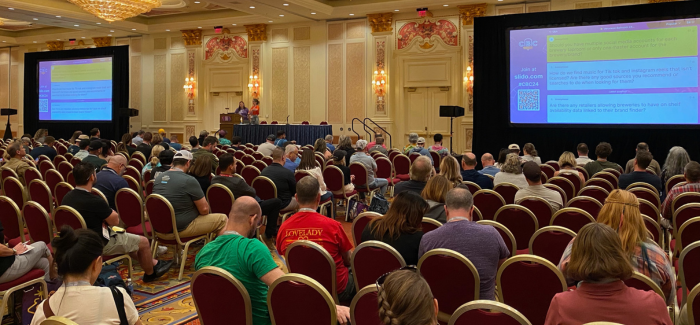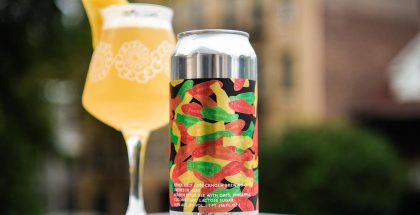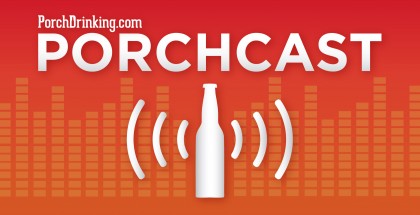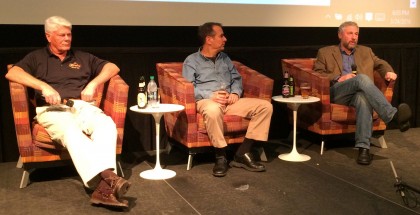Highs and Lows of the 2024 Craft Brewers Conference

- Julie Rhodes
- On May 7, 2024
- https://www.notyourhobbymarketing.com
With more curves than a Bart Watson data chart, the 2024 Craft Brewers Conference in Las Vegas did not disappoint for the 9,000-plus attendees who braved the lights and sounds of The Venetian Expo Center and cacophony of Phish fans pouring into The Sphere. (Talk about fantastic people watching!) The conference provided a sanctuary for industry professionals to discuss the myriad challenges and emerging opportunities within the craft brewing world.
Anchored by pre-conference events like Thrive and the Strategic Financial Planning Workshop, the conference offered a diverse array of educational sessions that underscored crucial themes such as business strategy, regulatory shifts, inclusion and mental health. Not to be downplayed, production-focused educational sessions were also in abundance, including a deep dive into the introduction of the “Brewing For Impact” initiative based on an ancient African grain called fonio and spearheaded by Garrett Oliver, the James Beard award-winning brewmaster from Brooklyn Brewery. But despite the current industry headwinds, most attendees walked away with a renewed sense of optimism, emboldened by the possibilities for growth and transformation gilded in cautionary tales.
Bad News First
A “Could Be Worse” headline graced a slide during the State of the Industry talk on Tuesday morning. This now infamous diatribe by the Brewers Association’s chief economist, Bart Watson, has become somewhat of a cult favorite, filled with data-packed charts and predictions for financial viability of the overall industry.
Beer production was down by 1% over 2022 and Watson addressed the elephant in the room directly by stating the burst of rapid growth our industry experienced in the 2000s and 2010s has now plateaued. Slow to no growth — the message given at last year’s State of Industry — should be the expectation of brewery owners for the next few years due to people just drinking less overall, reduced drinking occasions, shrinking interest in craft beer by younger generations, and more beverage options for legal drinking age (LDA, for short) consumers driven by visibility through digital marketing channels.
Additional takeaways included an overview of how owners might have to pivot their business to make products “beyond beer,” tackling the challenge of remaining innovative in a seemingly maxed-out style space, and changing up their business models to appeal to new audiences.

A New Cultural Challenger
While market saturation and reaching new audiences dominated most business-focused conversations throughout the week, another challenger entered the ring — neo-prohibitionist movements. For those who need a vocabulary glow up, neo-prohibitionism is a movement to stop the consumption of alcohol through policies and legislation that would limit the sale, marketing and possession of alcoholic beverages. Recent sentiments of the younger LDA crowd is that sobriety or moderation is the new cool, and through modern initiatives led by neo-prohibitionist lobbyists, breweries need to be hyperaware that consumption might see an overall dip in the foreseeable future.
The movement is a staunch reminder that breweries need to keep an eye on the current regulatory environment, participate in voting meetings, get involved with their state guilds and trade associations, and consider climbing the Hill to advocate for beer.
On the Bright Side
Despite the business woes expressed throughout the week, overall there was a spirit of optimism that prevailed. Many talks turned from “the sky is falling” to “where we can make money.” With business strategy on the minds of owners and operators, some of the most popular educational sessions included topics about financial literacy, varying production models, product innovation, sales and marketing optimization, chain business, increasing draft sales in the on-premise market segment and diversification of revenue streams.
Top of mind for attendees were questions such as: How can my brand stand out from the crowd? And how can we find new audiences for craft beer? Watson summed it up best with his wrap-up for the State of Industry in stating that craft beer started off as different from any other beverage, and we have to get back to that idea to see long-term success.
A Changing Industry
Something that was blatantly different about the 2024 Craft Brewers Conference is how much the industry has changed over the years. Programming now includes topics like employee burnout, addressing inclusion and equity, acknowledging mental health needs, recognizing the diverse history of beer in general, addressing the challenges of running a business with family and partners, human resources education and nurturing resource programs that could potentially make the industry a more level playing field.
Behavior expectations for the event were visible and resources for support were on every conference badge. From gender-neutral restrooms and personal pronoun buttons, to the Wellness Lounge and therapy dogs, the Craft Brewers Conference has transformed into a more human-forward event than just a professional conference. The faces of craft beer are changing and whether it’s Beny Ashburn of Crowns and Hops and Fawn Weaver, CEO and founder of Uncle Nearest, waxing effortlessly poetic during the keynote address or Kevin Asato preaching about the evolution of community with the National Black Brewers Association, a new era is here and if it’s not recognized and nurtured, the entire industry cannot move forward or flourish.
An event on Monday evening, the annual Brewsters Arm Wrestling Showdown at the Swan Dive to benefit the Wild West Access Fund, set the tone for the rest of the week. Sixteen women, nonbinary and trans folks in beer gathered to “get weird and have fun” to raise funds for abortion care for Nevada residents, and the crowd was a microcosm of what the beer industry could look like if conferences continue to move forward with this type of intention. People of various identities — young and old, brown and Black, people with disabilities, neurodivergent and genderfluid — filled the room with a vibe that can only be described as just plain joy.
While the consensus remains that “things are bad, but they could be worse,” the conference instilled a sense of hope and optimism that the beer industry is far from stagnant. By seeking inspiration beyond traditional boundaries, breweries can cultivate the resilience and ingenuity necessary to navigate these uncertain times. The road ahead will require innovation and collaboration, but this year’s conference made clear that the craft brewing community is at least taking a few steps in the right direction.
Related Posts
Trendy Fad or Innovation in Beer? Inside the Curious Case for Hazy IPAs... March 29, 2018 | Patrick Combs

The PorchCast | Ep 23 Bart Watson – The Brewers Association... July 26, 2016 | Tristan Chan

Weekly Growler Fill | National Beer News Roundup... April 4, 2016 | Chelsea Mitchell

The Weekly Buzz | October 28 – November 3... November 4, 2016 | Dan Bortz




Submit a Comment